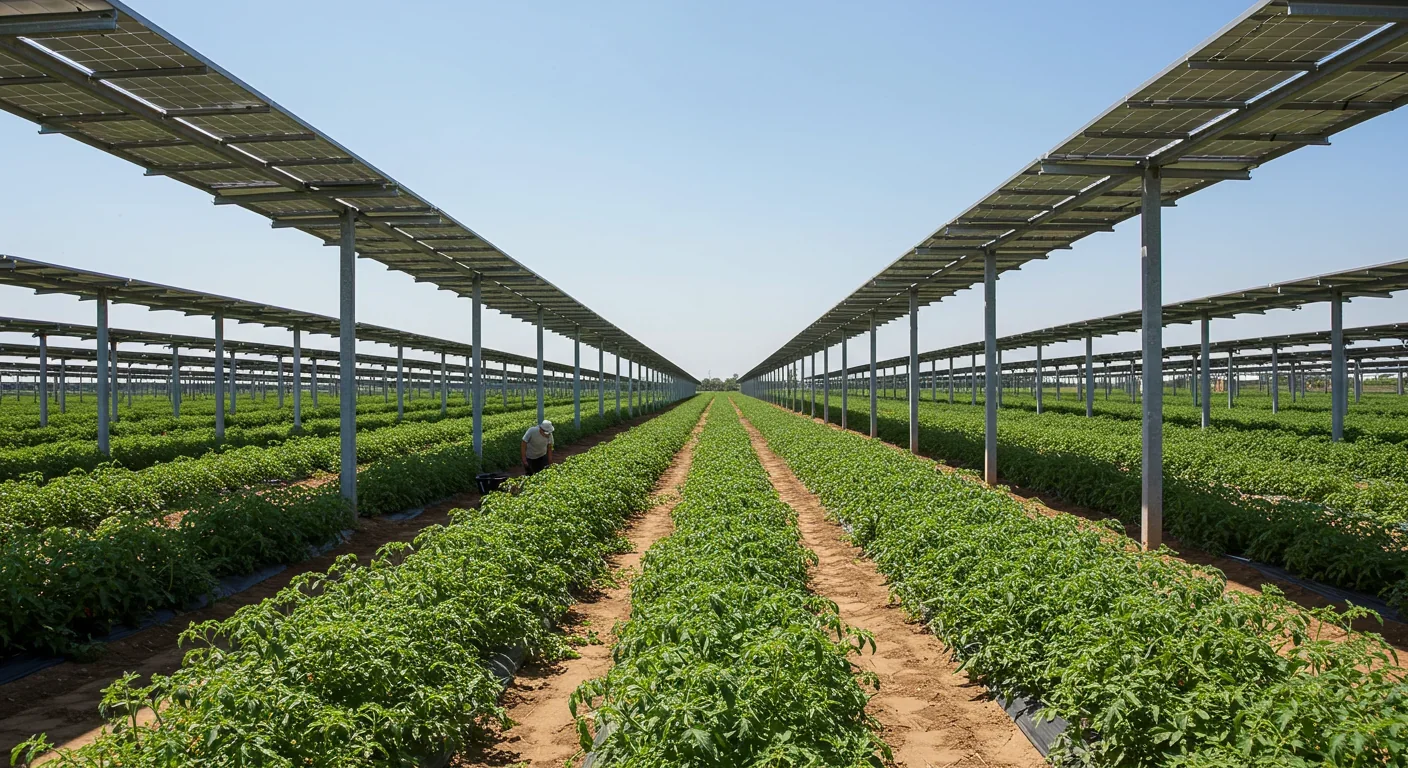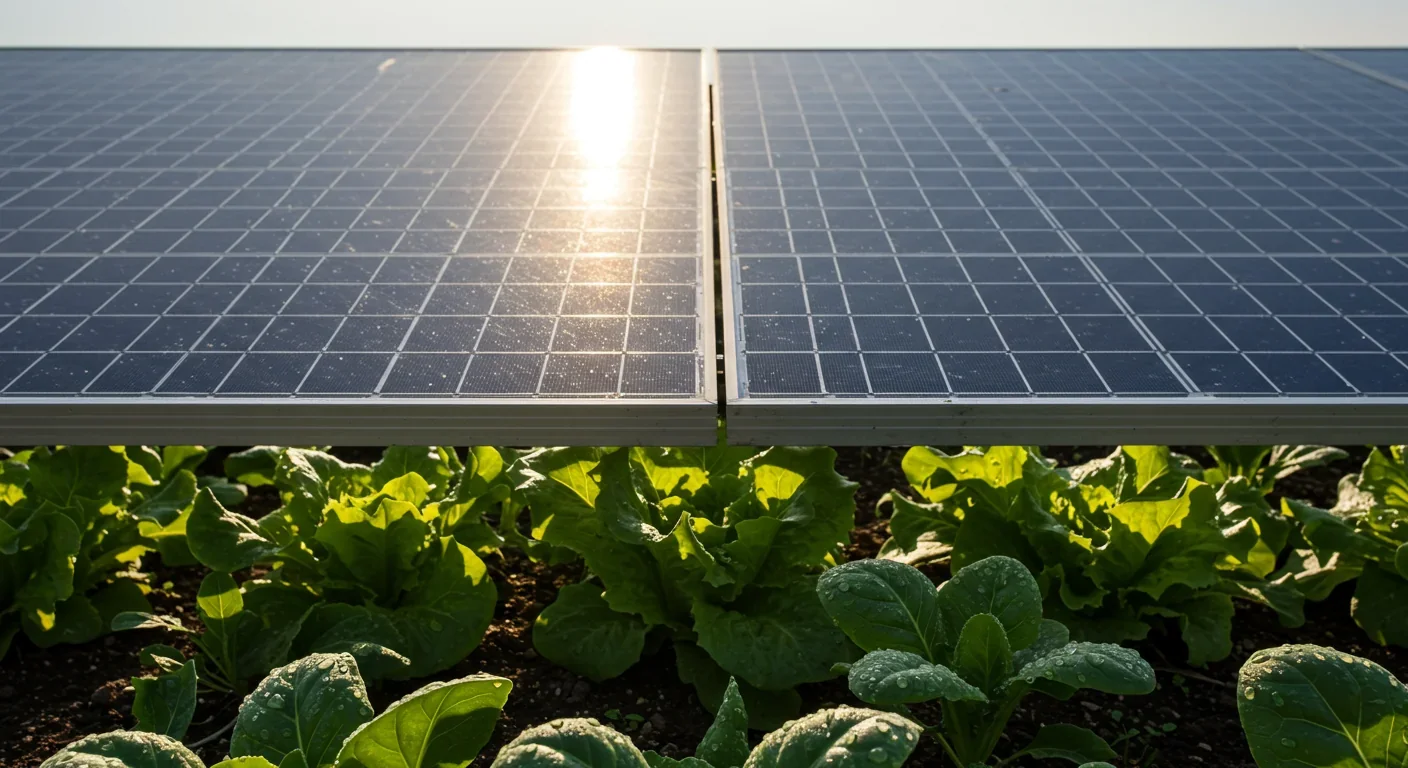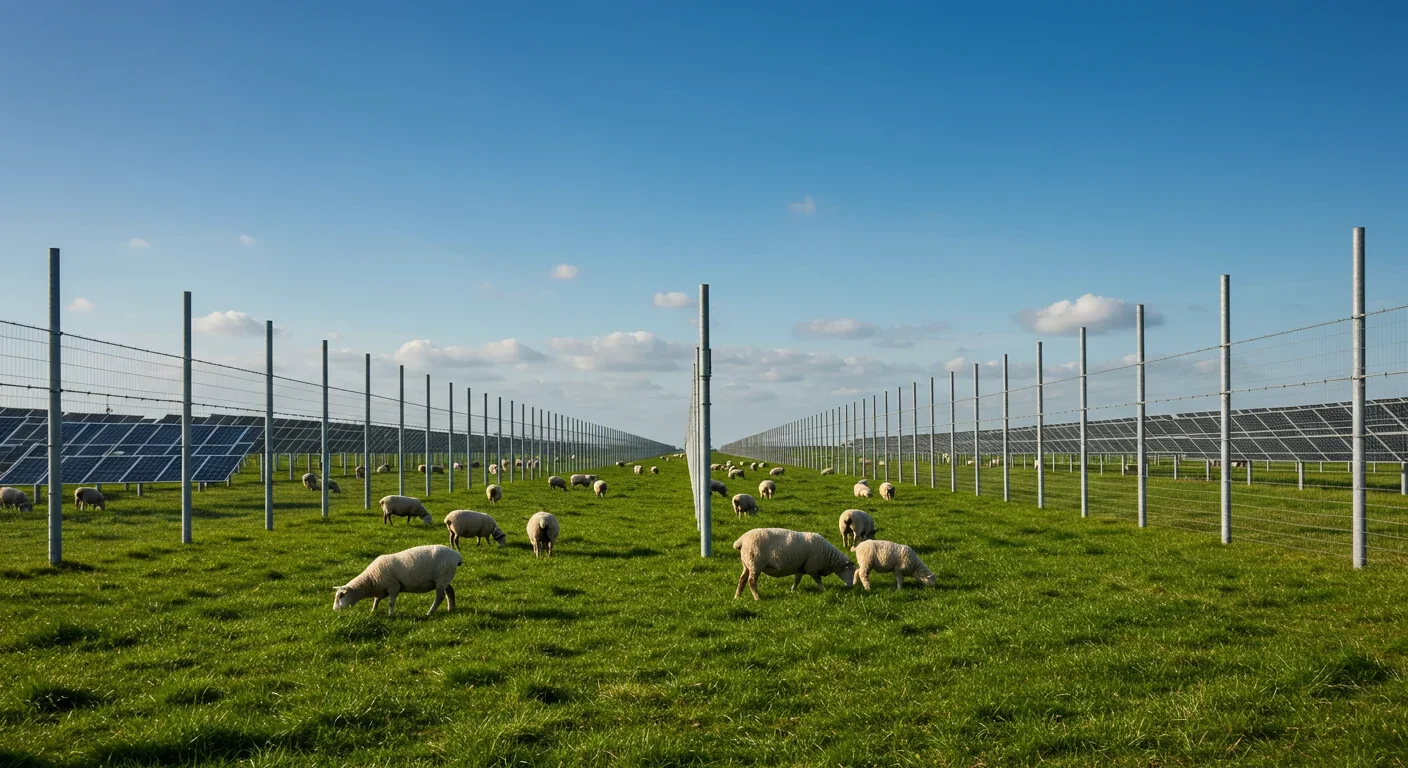Underground Air Storage: Renewable Energy's Hidden Battery

TL;DR: Agrivoltaics combines solar panels and farming on the same land, boosting crop yields by up to 300%, saving water by 157%, and generating dual income streams for farmers while addressing climate and food security challenges.

By 2050, Earth will need to feed 10 billion people while slashing carbon emissions by half. That's not just a challenge—it's an existential paradox. Agriculture already claims 40% of ice-free land and guzzles 70% of freshwater, yet we need more food, not less. Traditional solar farms compete with crops for precious farmland. But what if the same acre could do both? Welcome to agrivoltaics, where solar panels and vegetables grow side by side, transforming the zero-sum game of land use into a win-win for energy, food, and farmers' wallets.
Agrivoltaics isn't science fiction anymore. It's happening right now on farms from Colorado to Germany to Jordan. The concept is elegantly simple: mount solar panels high enough that tractors can drive underneath, space them so sunlight filters through, and grow crops in the dappled shade below. What researchers discovered shocked even the optimists. In a landmark 2019 study from the universities of Arizona and Maryland, crops under solar panels became 100% to 300% more productive depending on species. Water consumption dropped 157%, irrigation needs fell 15%, and the panels themselves generated 2% more electricity because evaporation from crops below cooled them by 16°F.
Think about that for a second. We've spent decades assuming that farming and energy production were competing interests, fighting over the same land. Turns out, they help each other. The crops cool the panels, making them more efficient. The panels shade the crops, reducing water stress and heat damage. Land use efficiency increases by 60-70% when you combine both uses. It's not compromise—it's synergy.
The numbers tell a compelling story. Global agrivoltaic capacity exploded from just 5 megawatts eight years ago to 2.9 gigawatts today. The National Renewable Energy Laboratory estimates that covering just 1 million acres of U.S. farmland with solar panels would meet the nation's renewable energy goals. In Europe, using merely 1% of existing farmland for agrivoltaics could generate over 900 gigawatts of power—a sixfold increase without claiming a single additional acre.
Byron Kominek's story captures the transformation. His Colorado farm was struggling, revenues flat, debts mounting. Local authorities told him, "Land's for farming, so go farm it." He replied, "Well, we weren't making any money. You all want to be 100% renewable at some point, so how about we work together and sort this out." The result? Jack's Solar Garden, once the world's largest agrivoltaic farm, spanning 24 acres with 3,200 solar panels. It now powers 300 homes, with 50 energy clients including the city and county government. Underneath the panels grow tomatoes, turnips, carrots, squash, beets, lettuce, kale, chard, and peppers.
The panels are mounted 8 feet off the ground so Kominek can drive his tractor underneath, treating it like any other field. The financial risk was terrifying—he had to put up his entire farm as collateral. "If this doesn't work, we lose the farm," he admitted. But it did work. Now he's earning from two revenue streams on the same land: selling vegetables and selling electricity. That dual income model is agrivoltaics' killer app for farmers. Some operations report earning $50,000 per acre from combined agriculture and energy production, making it one of the most profitable land uses available.
This isn't a niche experiment confined to wealthy Western farms. In Jordan, a water-scarce nation where agriculture competes desperately for every drop, researchers collected 444 liters of water from just 4 square meters of solar panels over two months by harvesting condensation and rain runoff. The panels serve triple duty: generating electricity, shading crops, and collecting water. One study found that a farmer can offset a cow's methane emissions with just 4.1 square meters of solar panels, creating a pathway to carbon-neutral livestock operations.
Not all crops thrive under panels, and that matters. Shade-loving crops like basil, broccoli, celery, peppers, corn, lettuce, potatoes, spinach, strawberries, and tomatoes show increased yields, while sun-hungry staples like wheat, rice, and soybeans may suffer. This creates a strategic decision point: agrivoltaics works best for high-value specialty crops and vegetables, not grain monocultures. That's actually a feature, not a bug. Specialty crops command higher prices per acre, making the dual-use model economically attractive. You wouldn't agrivoltaic a Kansas wheat field, but a California strawberry farm or an organic vegetable operation? That's the sweet spot.
The microclimate effects are fascinating. Solar panels reduce evapotranspiration, prevent soil erosion, and boost biodiversity by creating varied shade patterns that different species exploit. In desert trials, California researchers found 14-29% water savings for cucumbers and lettuce, while an Arizona study reported 50% water reduction for certain crops. These aren't marginal improvements; they're game-changers in a warming world where droughts are intensifying and aquifers are depleting.
Temperature regulation matters too. Heat stress is a major threat to crops, and climate models predict more extreme heat waves that will damage yields. Panels provide protective shade exactly when plants need it most—during peak sun hours. Meanwhile, the shade doesn't block enough light to starve the crops; instead it creates a "Goldilocks zone" of filtered sunlight that many species prefer. It's like giving your garden an adjustable parasol tuned to optimize photosynthesis.

Agrivoltaics isn't just for vegetables. Livestock grazing under solar panels represents a massive opportunity because rangelands cover enormous areas where traditional solar would never make sense. A pioneering study by Statkraft, CVE, and INRAE tracked sheep grazing under photovoltaic panels from 2022 to 2023, finding no adverse effects on sheep health or behavior. The panels provided shade and protection against heat stress during summer, which actually improved animal welfare. Sheep keep vegetation trimmed under the panels, eliminating mowing costs and creating a symbiotic relationship where the animals maintain the solar farm while benefiting from shelter.
Pollinators add another dimension. Solar farms often plant native wildflowers and grasses underneath panels, creating pollinator habitats that support bees, butterflies, and beneficial insects. This addresses the pollinator crisis while improving yields for nearby crops that depend on insect pollination. You can graze sheep on pollinator-friendly plants part of the year, harvest honey from beehives stationed among the panels, and still generate clean electricity—all from the same land. It's a multi-layered ecosystem that produces food, energy, and ecological services simultaneously.
Panel design matters enormously. Early agrivoltaic systems used fixed-tilt panels that cast permanent shadows, limiting crop options. Modern installations use tracking panels that follow the sun, distributing shade more evenly throughout the day. Vertical bifacial panels represent the cutting edge: mounted vertically along fence lines or in rows, they capture sunlight from both sides while minimizing shade. These systems work especially well for existing agricultural fences, retrofitting infrastructure that's already there. Bifacial efficiency reaches 76%, and the vertical orientation creates alternating strips of sun and shade that farmers can plant strategically.
Height flexibility is crucial. Mounting panels 6-8 feet high allows tractor access for standard farming operations, but some crops need less clearance while others (like greenhouse shade structures) integrate panels into existing buildings. Open-source designs using wood-based racking have lowered costs dramatically compared to steel, making agrivoltaics accessible to smaller farms in developing countries. The levelized cost of electricity (LCOE) from vertical systems can actually beat conventional solar farms in some contexts because the racking is simpler and land costs are split between energy and agriculture.
Spacing between panel rows determines what you can grow. Wider spacing (10-15 feet) allows full-size crops and heavy machinery but generates less electricity per acre. Tighter spacing (3-5 feet) maximizes energy but limits crops to shade-tolerant species and restricts equipment access. Adjustable systems that can be tilted seasonally let farmers optimize for peak crop growth during planting season and peak energy during harvest, giving them control over the tradeoff.
Let's talk money. Traditional solar leases pay farmers roughly $500-$2,000 per acre annually to give up their land entirely. Agrivoltaics lets them keep farming while adding energy revenue, potentially exceeding $50,000 per acre for high-value crops plus electricity sales. That math transforms farm economics, especially for operations on marginal land where crop yields are low but solar resources are excellent. Farmers near urban areas particularly benefit because they can sell fresh vegetables locally while feeding clean power to nearby cities.
Upfront costs remain the biggest barrier. A conventional solar installation might run $3-$5 per watt, but agrivoltaic systems cost more because panels must be elevated and spaced for farm equipment. Kominek's experience—putting his entire farm up as collateral—illustrates the financial risk. Banks don't yet understand agrivoltaics well enough to offer favorable terms, and many farmers can't secure capital for such novel projects. Government subsidies help; Germany, France, Japan, and several U.S. states offer grants or tax incentives for agrivoltaic installations. As the technology proves itself, financing will improve.
Energy prices also matter. In regions with high electricity costs or strong net metering policies, the economics become compelling faster. Feed-in tariffs that guarantee long-term energy prices give farmers revenue certainty, making the investment less risky. Community solar models, where multiple farms or co-ops share a larger agrivoltaic installation, spread capital costs and technical expertise across participants. This collective approach could accelerate adoption in rural areas where individual farmers lack resources but communities could band together.
Technical challenges persist. Some crops genuinely don't work under shade—wheat, corn for grain (as opposed to silage), and rice need full sun to maximize yields. For these staples that feed billions, agrivoltaics isn't viable, limiting the technology to perhaps 20-30% of global farmland where specialty crops, vegetables, fruits, or livestock dominate. That's still enormous, but it means agrivoltaics will complement, not replace, traditional agriculture.
Maintenance complexity increases when you combine farming and energy systems. Panels need cleaning, but you can't use heavy equipment that would compact soil or damage crops. Irrigation systems must navigate panel supports. Electrical components must withstand dust, moisture, and agricultural chemicals. If a panel fails or a wiring issue emerges, repair crews need access without trampling crops. These operational headaches are solvable but require planning and coordination that farmers aren't used to.
Regulatory barriers loom large. Many agricultural zoning laws prohibit commercial energy generation on farmland, or classify solar installations as industrial use, triggering loss of agricultural tax exemptions and subsidies. Permitting processes can take years, and local opposition ("not in my backyard") often blocks projects even when farmers support them. Interestingly, agrivoltaics reduces NIMBY resistance: a U.S. survey found 81.8% of respondents more likely to support solar development when agriculture continues on site, because it preserves rural character and farming communities.

Japan pioneered agrivoltaics in 2004 and remains a leader, with thousands of installations nationwide. The Japanese government offers subsidies and has streamlined permitting for farms that maintain at least 80% of original crop yields. This "productivity threshold" approach balances energy goals with food security, ensuring agrivoltaics genuinely serves dual purposes rather than becoming a backdoor to convert farmland into pure solar farms.
Europe is scaling fast. Germany's renewable energy transition (Energiewende) includes substantial agrivoltaic deployment, with major utilities like Statkraft launching dedicated agrivoltaic divisions. France created special funding programs after a 2020 law encouraged agricultural solar. The EU's Common Agricultural Policy now allows agrivoltaics to qualify for certain farm subsidies, removing a major obstacle. By treating agrivoltaic land as agricultural rather than industrial, EU policy enables farmers to adopt solar without losing support payments.
In the developing world, agrivoltaics addresses different problems. For water-scarce regions like the Middle East, North Africa, and India, the water savings and shade benefits matter more than dual revenue. Solar-powered irrigation pumps combined with agrivoltaic shade create self-contained systems where panels power water pumps that irrigate crops growing beneath them. This closes the loop, making farming possible in places that would otherwise struggle. China is experimenting with massive agrivoltaic installations in desert regions, attempting to green marginal lands through the cooling and water-conserving effects of panels.
Governments are waking up to agrivoltaics' potential. The U.S. Department of Agriculture launched a $10 million grant program in 2023 specifically for agrivoltaic research and demonstration projects. California's Self-Generation Incentive Program and Solar on Multifamily Affordable Housing program both include carve-outs for agricultural solar. These policies signal shifting priorities toward multi-benefit infrastructure that serves food, energy, climate, and rural economic development simultaneously.
Investment capital is following. Venture funds focused on climate tech are backing agrivoltaic startups that offer turnkey systems, financing packages, and technical support to farmers. Corporate agricultural giants like Cargill and ADM are exploring agrivoltaics on their own lands and supply chains. Renewable energy developers increasingly view agrivoltaics as a way to access farmland for solar projects without the backlash that pure solar farms provoke. The business models are converging around power purchase agreements (PPAs) where developers own and maintain the solar equipment while farmers continue operating the land, sharing revenues from both crops and energy.
Insurance and finance sectors need to catch up. Few banks have specialized agrivoltaic loan products, and agricultural insurance policies don't clearly cover damage to solar panels from farm equipment or crop failure related to shade. As the industry matures, expect bundled insurance products that cover both agricultural and energy risks, plus specialized lenders who understand the dual revenue model and can price risk accordingly.
If you're a farmer, the decision to adopt agrivoltaics hinges on your crops, land quality, and proximity to energy markets. High-value specialty crops on marginal land near urban electricity demand offer the best returns. Start small—a single acre demonstration plot proves the concept without risking your entire operation. Partner with universities or extension services running agrivoltaic research; many offer free technical assistance or cost-sharing for data collection. Join farmer networks or co-ops exploring shared installations to spread costs and learning curves.
For policymakers, the imperative is clear: update zoning codes and agricultural subsidies to recognize agrivoltaics as legitimate farming. Streamline permitting for installations that maintain minimum crop productivity. Offer grants or tax credits that offset upfront capital costs, recognizing the public benefits of dual-use land in climate mitigation, water conservation, and rural economic resilience. Create demonstration projects on public lands to showcase what's possible and build political support.
Investors and developers should focus on regions with high electricity prices, strong agricultural sectors, water scarcity, and supportive policies. The technology is proven; the business models work; the barriers are primarily regulatory and financial, not technical. Companies that can offer farmers zero-upfront-cost installations through PPAs or lease arrangements, backed by 20-year energy contracts, will capture market share quickly.
Agrivoltaics represents something rare: a genuine win-win-win solution to overlapping crises. It produces clean energy without consuming land. It improves crop yields and water efficiency while generating farm income. It mitigates climate change, supports food security, and revitalizes rural economies. Technologies this good usually involve tradeoffs or hidden costs. Agrivoltaics keeps revealing new benefits the more we study it—cooler panels, better pollinator habitat, carbon-neutral livestock, water collection in deserts.
This is what breakthrough innovation looks like when it arrives. Not flashy or dramatic, but elegantly logical in hindsight. Of course we should grow food and generate electricity on the same land. Why did we think we had to choose? The question now isn't whether agrivoltaics will scale, but how fast. With global food demand rising, climate pressures intensifying, and energy transitions accelerating, the dual-use model offers a rare pathway forward that doesn't force agonizing choices between competing needs.
In twenty years, your vegetables might come from farms where solar panels outnumber trees. Your electricity might flow from fields that also graze sheep and harvest honey. This isn't a distant future requiring miraculous technology. It's already happening on farms you can visit today. The revolution is quiet because it's practical, proven, and profitable. That's exactly why it will succeed.

MOND proposes gravity changes at low accelerations, explaining galaxy rotation without dark matter. While it predicts thousands of galaxies correctly, it struggles with clusters and cosmology, keeping the dark matter debate alive.

Ultrafine pollution particles smaller than 100 nanometers can bypass the blood-brain barrier through the olfactory nerve and bloodstream, depositing in brain tissue where they trigger neuroinflammation linked to dementia and neurological disorders, yet remain completely unregulated by current air quality standards.

CAES stores excess renewable energy by compressing air in underground caverns, then releases it through turbines during peak demand. New advanced adiabatic systems achieve 70%+ efficiency, making this decades-old technology suddenly competitive for long-duration grid storage.

Our brains are hardwired to see patterns in randomness, causing the gambler's fallacy—the mistaken belief that past random events influence future probabilities. This cognitive bias costs people millions in casinos, investments, and daily decisions.

Forests operate as synchronized living systems with molecular clocks that coordinate metabolism from individual cells to entire ecosystems, creating rhythmic patterns that affect global carbon cycles and climate feedback loops.

Generation Z is the first cohort to come of age amid a polycrisis - interconnected global failures spanning climate, economy, democracy, and health. This cascading reality is fundamentally reshaping how young people think, plan their lives, and organize for change.

Zero-trust security eliminates implicit network trust by requiring continuous verification of every access request. Organizations are rapidly adopting this architecture to address cloud computing, remote work, and sophisticated threats that rendered perimeter defenses obsolete.